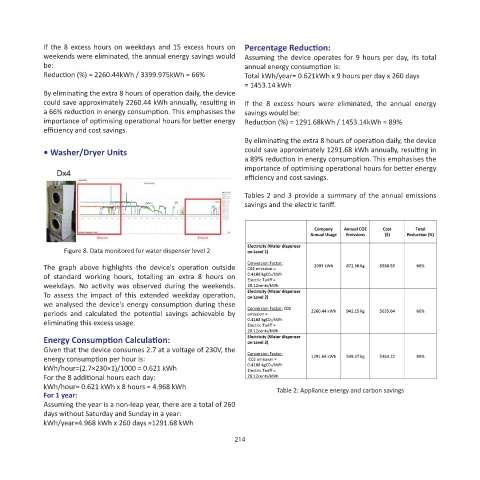Page 216 - Towards A Sustainable Future , Phase 3 2025, E-Book_Neat
P. 216
If the 8 excess hours on weekdays and 15 excess hours on Percentage Reduction:
weekends were eliminated, the annual energy savings would Assuming the device operates for 9 hours per day, its total
be: annual energy consumption is:
Reduction (%) = 2260.44kWh / 3399.975kWh = 66% Total kWh/year= 0.621kWh x 9 hours per day x 260 days
= 1453.14 kWh
By eliminating the extra 8 hours of operation daily, the device
could save approximately 2260.44 kWh annually, resulting in If the 8 excess hours were eliminated, the annual energy
a 66% reduction in energy consumption. This emphasises the savings would be:
importance of optimising operational hours for better energy Reduction (%) = 1291.68kWh / 1453.14kWh = 89%
efficiency and cost savings.
By eliminating the extra 8 hours of operation daily, the device
• Washer/Dryer Units could save approximately 1291.68 kWh annually, resulting in
a 89% reduction in energy consumption. This emphasises the
importance of optimising operational hours for better energy
efficiency and cost savings.
Tables 2 and 3 provide a summary of the annual emissions
savings and the electric tariff.
Figure 8. Data monitored for water dispenser level 2
The graph above highlights the device's operation outside
of standard working hours, totalling an extra 8 hours on
weekdays. No activity was observed during the weekends.
To assess the impact of this extended weekday operation,
we analysed the device's energy consumption during these
periods and calculated the potential savings achievable by
eliminating this excess usage.
Energy Consumption Calculation:
Given that the device consumes 2.7 at a voltage of 230V, the
energy consumption per hour is:
kWh/hour=(2.7×230×1)/1000 = 0.621 kWh
For the 8 additional hours each day:
kWh/hour= 0.621 kWh x 8 hours = 4.968 kWh Table 2: Appliance energy and carbon savings
For 1 year:
Assuming the year is a non-leap year, there are a total of 260
days without Saturday and Sunday in a year:
kWh/year=4.968 kWh x 260 days =1291.68 kWh
214

